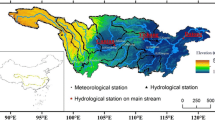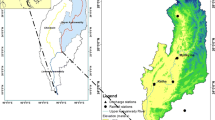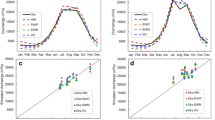Abstract
The effects of climate and land use changes on the hydrological cycle are important factors affecting the evolution of aquatic ecosystems. In this study, the streamflow response to future climate change and land use change and their relative effect is investigated using a Coupled Model Intercomparison Project Phase 5 multi-model ensemble, in conjunction with a raster-based Xin’anjiang model to simulate future streamflows under three climate change scenarios (RCP 2.6, RCP 4.5, and RCP 8.5) and three land use change scenarios (“constant,” “current rate,” and “double rate”) in the Xinjiang basin, China. The results show that the monthly streamflows in the period of 2020–2055 increase substantially at rates ranging from 5.9 to 35.5 % in the autumn and early winter months, but those decrease at rates ranging from −5.5 to −48.1 % in the other months. Annual streamflow also significantly decreases by 148–279 mm under different climate and land use change scenarios. The relative effect of climate change on annual and most monthly streamflows is significantly higher than that of land use change. However, the land use change effect becomes increasingly evident over time and can mitigate the climate change effect from January to August and enhance it in the other months. Moreover, the relative effect of land use change on streamflow is relatively greater in the dry period than that in wet period.








Similar content being viewed by others
References
Agrawal A, Sharma AR, Tayal S (2014) Assessment of regional climatic changes in the Eastern Himalayan region: a study using multi-satellite remote sensing data sets. Environ Monit Assess 186:6521–6536. doi:10.1007/s10661-014-3871-x
Ahn K-H, Merwade V (2014) Quantifying the relative impact of climate and human activities on streamflow. J Hydrol 515:257–266. doi:10.1016/j.jhydrol.2014.04.062
Allen RG, Pereira LS, Raes D, Smith M (1998) Crop evapotranspiration—guidelines for computing crop water requirements. FAO irrigation and drainage paper 56. FAO, Rome 300:D05109
Ding Y, Ren G, Zhao Z, Xu Y, Luo Y, Li Q, Zhang J (2007) Detection, causes and projection of climate change over China: an overview of recent progress. Adv Atmos Sci 24:954–971
Finger D, Vis M, Huss M, Seibert J (2015) The value of multiple data set calibration versus model complexity for improving the performance of hydrological models in mountain catchments. WRR 51(4):1939–1958
Goovaerts P (2000) Geostatistical approaches for incorporating elevation into the spatial interpolation of rainfall. J Hydrol 228:113–129. doi:10.1016/S0022-1694(00)00144-X
Guo H, Hu Q, Jiang T (2008) Annual and seasonal streamflow responses to climate and land-cover changes in the Poyang Lake basin, China. J Hydrol 355:106–122. doi:10.1016/j.jhydrol.2008.03.020
Hallema DW et al (2014) Framework for studying the hydrological impact of climate change in an alley cropping system. J Hydrol 517:547–556. doi:10.1016/j.jhydrol.2014.05.065
Hu Q, Feng S, Guo H, Chen G, Jiang T (2007) Interactions of the Yangtze river flow and hydrologic processes of the Poyang Lake, China. J Hydrol 347:90–100. doi:10.1016/j.jhydrol.2007.09.005
Huang J, Gao J, Xu Y, Liu J (2015) Towards better environmental software for spatio-temporal ecological models: lessons from developing an intelligent system supporting phytoplankton prediction in lakes. Ecol Inform 25:49–56
Jiang S, Ren L, Yong B, Singh V, Yang X, Yuan F (2011) Quantifying the effects of climate variability and human activities on runoff from the Laohahe basin in northern China using three different methods. Hydrol Process 25:2492–2505
Jiang S, Ren L, Yong B, Fu C, Yang X (2012) Analyzing the effects of climate variability and human activities on runoff from the Laohahe basin in northern China. Hydrol Res 43:3–13
Jiang C, Xiong L, Wang D, Liu P, Guo S, Xu C-Y (2015) Separating the impacts of climate change and human activities on runoff using the Budyko-type equations with time-varying parameters. J Hydrol 522:326–338. doi:10.1016/j.jhydrol.2014.12.060
Kalantari Z, Lyon SW, Folkeson L, French HK, Stolte J, Jansson PE, Sassner M (2014) Quantifying the hydrological impact of simulated changes in land use on peak discharge in a small catchment. Sci Total Environ 466:741–754. doi:10.1016/j.scitotenv.2013.07.047
Kalantari Z, Lyon SW, Jansson P-E, Stolte J, French HK, Folkeson L, Sassner M (2015) Modeller subjectivity and calibration impacts on hydrological model applications: an event-based comparison for a road-adjacent catchment in south-east Norway. Sci Total Environ 502:315–329
Lahmer W, Pfützner B, Becker A (2001) Assessment of land use and climate change impacts on the mesoscale. Phys Chem Earth Part B 26:565–575
Legesse D, Vallet-Coulomb C, Gasse F (2003) Hydrological response of a catchment to climate and land use changes in Tropical Africa: case study South Central Ethiopia. J Hydrol 275:67–85
Meng D, Mo X (2012) Assessing the effect of climate change on mean annual runoff in the Songhua River basin, China. Hydrol Process 26:1050–1061
Myneni R, Williams D (1994) On the relationship between FAPAR and NDVI. Remote Sens Environ 49:200–211
Neitsch SL, Arnold JG, Kiniry JR, Williams JR (2011) Soil and water assessment tool theoretical documentation version 2009. Texas Water Resources Institute, College Station
Neupane RP, Kumar S (2015) Estimating the effects of potential climate and land use changes on hydrologic processes of a large agriculture dominated watershed. J Hydrol 529(Part 1):418–429. doi:10.1016/j.jhydrol.2015.07.050
Niedda M, Pirastru M, Castellini M, Giadrossich F (2014) Simulating the hydrological response of a closed catchment-lake system to recent climate and land-use changes in semi-arid Mediterranean environment. J Hydrol 517:732–745. doi:10.1016/j.jhydrol.2014.06.008
Nyeko M (2015) Hydrologic modelling of data scarce basin with SWAT model: capabilities and limitations. Water Resour Manag 29:81–94. doi:10.1007/s11269-014-0828-3
Ouyang F, Lü H, Zhu Y, Zhang J, Yu Z, Chen X, Li M (2014) Uncertainty analysis of downscaling methods in assessing the influence of climate change on hydrology. Stoch Environ Res Risk Assess 28:991–1010. doi:10.1007/s00477-013-0796-9
Pavanelli D, Capra A (2014) Climate change and human impacts on hydroclimatic variability in the Reno River Catchment, Northern Italy. CLEAN Soil Air Water 42:535–545. doi:10.1002/clen.201300213
Piao S et al (2010) The impacts of climate change on water resources and agriculture in China. Nature 467:43–51
Rouge C, Cai XM (2014) Crossing-scale hydrological impacts of urbanization and climate variability in the Greater Chicago Area. J Hydrol 517:13–27. doi:10.1016/j.jhydrol.2014.05.005
Sharpley AN, Williams JR (1990) EPIC-erosion/productivity impact calculator: 1. Model documentation. Technical Bulletin, United States Department of Agriculture
Smith I, Syktus J, McAlpine C, Wong K (2013) Squeezing information from regional climate change projections—results from a synthesis of CMIP5 results for south-east Queensland, Australia. Clim Change 121:609–619
Stocker T et al (2013) IPCC, 2013: climate change 2013: the physical science basis. Contribution of Working Group I to the fifth assessment report of the Intergovernmental Panel on Climate Change
Sun S, Chen H, Ju W, Hua W, Yu M, Yin Y (2013) Assessing the future hydrological cycle in the Xinjiang Basin, China, using a multi-model ensemble and SWAT model. Int J Climatol 34:2972–2987. doi:10.1002/joc.3890
Svoray T, Bar P, Bannet T (2005) Urban land-use allocation in a Mediterranean ecotone: Habitat Heterogeneity Model incorporated in a GIS using a multi-criteria mechanism. Landsc Urban Plan 72:337–351. doi:10.1016/j.landurbplan.2004.05.001
Syvitski JP et al (2009) Sinking deltas due to human activities. Nat Geosci 2:681–686
Tian D, Guo Y, Dong W (2015) Future changes and uncertainties in temperature and precipitation over China based on CMIP5 models. Adv Atmos Sci 32:487–496
Tisseuil C, Vrac M, Lek S, Wade AJ (2010) Statistical downscaling of river flows. J Hydrol 385:279–291. doi:10.1016/j.jhydrol.2010.02.030
Tu J (2009) Combined impact of climate and land use changes on streamflow and water quality in eastern Massachusetts, USA. J Hydrol 379:268–283. doi:10.1016/j.jhydrol.2009.10.009
USDA-SCS (1986) Urban hydrology for small watersheds. U.S. Department of Agriculture Technical Release No.55, Washington, DC
Van der Knijff J, De Roo A (2008) LISFLOOD. Distributed water balance and flood simulation model—revised user manual. European Commission [EUR 22166 EN/2] Joint Research Centre, Institute for Environment and Sustainability, Ispra
Van Deursen W (1995) Geographical information systems and dynamic models: development and application of a prototype spatial modelling language. Universiteit Utrecht, Utrecht
Wang J, Hong Y, Gourley J, Adhikari P, Li L, Su F (2010) Quantitative assessment of climate change and human impacts on long-term hydrologic response: a case study in a sub-basin of the Yellow River, China. Int J Climatol 30:2130–2137. doi:10.1002/joc.2023
Wisser D, Fekete BM, Vorosmarty CJ, Schumann AH (2010) Reconstructing 20th century global hydrography: a contribution to the Global Terrestrial Network-Hydrology (GTN-H). Hydrol Earth Syst Sci 14:1–24
Xie D, Yan Y, Deng H, Fang Y, Fan Z (2009) A study on the hydrological characters in the five river-catchments in JiangxiProvince. Acta Agric Univ Jiangxiensis 31:364–369 (in Chinese)
Xu CH, Xu Y (2012) The projection of temperature and precipitation over China under RCP scenarios using a CMIP5 multi-model ensemble. Atmos and Ocean Sci Lett 5:527–533
Yan RH, Huang JC, Wang Y, Gao JF, Qi LY (2015) Modeling the combined impact of future climate and land use changes on streamflow of Xinjiang Basin. Hydrol Res, China. doi:10.2166/nh.2015.206
Yang C, Yan Z, Shao Y (2012) Probabilistic precipitation forecasting based on ensemble output using generalized additive models and Bayesian model averaging. Acta Meteorol Sin 26:1–12. doi:10.1007/s13351-012-0101-8
Yao C, Li Z, Yu Z, Zhang K (2012) A priori parameter estimates for a distributed, grid-based Xinanjiang model using geographically based information. J Hydrol 468–469:47–62. doi:10.1016/j.jhydrol.2012.08.025
Zhang Q, Li L (2009) Development and application of an integrated surface runoff and groundwater flow model for a catchment of Lake Taihu watershed, China. Quat Int 208:102–108
Zhang A, Zhang C, Fu G, Wang B, Bao Z, Zheng H (2012) Assessments of impacts of climate change and human activities on runoff with SWAT for the Huifa River Basin, Northeast China. Water Resour Manag 26:2199–2217
Zhao RJ (1992) The Xinanjiang model applied in China. JHydrol 135:371–381
Zhao GJ, Hörmann G, Fohrer N, Gao J, Li H, Tian P (2010) Application of a simple raster-based hydrological model for streamflow prediction in a humid catchment with polder systems. Water Resour Manag 25:661–676. doi:10.1007/s11269-010-9719-4
Zhou M, Ishidaira H, Hapuarachchi H, Magome J, Kiem A, Takeuchi K (2006) Estimating potential evapotranspiration using Shuttleworth–Wallace model and NOAA-AVHRR NDVI data to feed a distributed hydrological model over the Mekong River basin. J Hydrol 327:151–173
Acknowledgments
This study was financially supported by National Basic Research Program of China (No. 2012CB417006) and National Natural Science Foundation of China (No. 41371061). We acknowledge Beijing National Climate Centre for providing processed future climate datasets.
Author information
Authors and Affiliations
Corresponding author
Rights and permissions
About this article
Cite this article
Yan, R., Gao, J. & Li, L. Streamflow response to future climate and land use changes in Xinjiang basin, China. Environ Earth Sci 75, 1108 (2016). https://doi.org/10.1007/s12665-016-5805-0
Received:
Accepted:
Published:
DOI: https://doi.org/10.1007/s12665-016-5805-0




